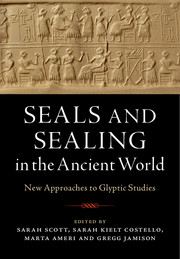 Seals and Sealing in the Ancient World
Seals and Sealing in the Ancient World Book contents
- Seals and Sealing in the Ancient World
- Seals and Sealing in the Ancient World
- Copyright page
- Contents
- Notes on Contributors
- Illustrations
- Plates
- Tables
- Acknowledgments
- Preface
- Abbreviations
- Chapter One Introduction: Small Windows, Wide Views
- Part I The Ancient Near East and Cyprus
- Chapter Two Administrative Role of Seal Imagery in the Early Bronze Age: Mesopotamian and Iranian Traders on the Plateau
- Chapter Three Slave Labor: Uruk Cylinder-Seal Imagery and Early Writing
- Chapter Four The First Female Bureaucrats: Gender and Glyptic in Third-Millennium Northern Mesopotamia
- Chapter Five Rematerializing the Early Dynastic Banquet Seal
- Chapter Six Sealing Practices in the Akkadian Period
- Chapter Seven Authenticity, Seal Recarving, and Authority in the Ancient Near East and Eastern Mediterranean
- Part II South Asia and the Gulf Region
- Part III Egypt
- Part IV Aegean
- References
- Endnotes
- Index
Chapter Five - Rematerializing the Early Dynastic Banquet Seal
from Part I - The Ancient Near East and Cyprus
Published online by Cambridge University Press: 24 April 2018
- Seals and Sealing in the Ancient World
- Seals and Sealing in the Ancient World
- Copyright page
- Contents
- Notes on Contributors
- Illustrations
- Plates
- Tables
- Acknowledgments
- Preface
- Abbreviations
- Chapter One Introduction: Small Windows, Wide Views
- Part I The Ancient Near East and Cyprus
- Chapter Two Administrative Role of Seal Imagery in the Early Bronze Age: Mesopotamian and Iranian Traders on the Plateau
- Chapter Three Slave Labor: Uruk Cylinder-Seal Imagery and Early Writing
- Chapter Four The First Female Bureaucrats: Gender and Glyptic in Third-Millennium Northern Mesopotamia
- Chapter Five Rematerializing the Early Dynastic Banquet Seal
- Chapter Six Sealing Practices in the Akkadian Period
- Chapter Seven Authenticity, Seal Recarving, and Authority in the Ancient Near East and Eastern Mediterranean
- Part II South Asia and the Gulf Region
- Part III Egypt
- Part IV Aegean
- References
- Endnotes
- Index
Summary
The banquet seal of third-millennium southern Mesopotamia is a rich source of information relating to the social, political, and religious practices of Sumerian elites, including women. Applying concepts of materiality to the banquet seal, I will argue that this type of seal came into use as part of broader changes in social order, in which elites used material culture, including seals, to establish and maintain their control over a social hierarchy that was becoming ever more steep. The banquet seal, with its image of elite feasting, helped structure and reinforce that social hierarchy. Made from materials in a limited range of colors, and carved with simple, legible scenes known in other media, the banquet seal was part of a suite of self-referential visual culture whose redundancy increased the power and readability of its message. This chapter demonstrates how viewing seals through the lens of materiality allows us to look beyond imagery and seal function to how seals helped constitute social relations.
- Type
- Chapter
- Information
- Seals and Sealing in the Ancient WorldCase Studies from the Near East, Egypt, the Aegean, and South Asia, pp. 68 - 80Publisher: Cambridge University PressPrint publication year: 2018
- 1
- Cited by
